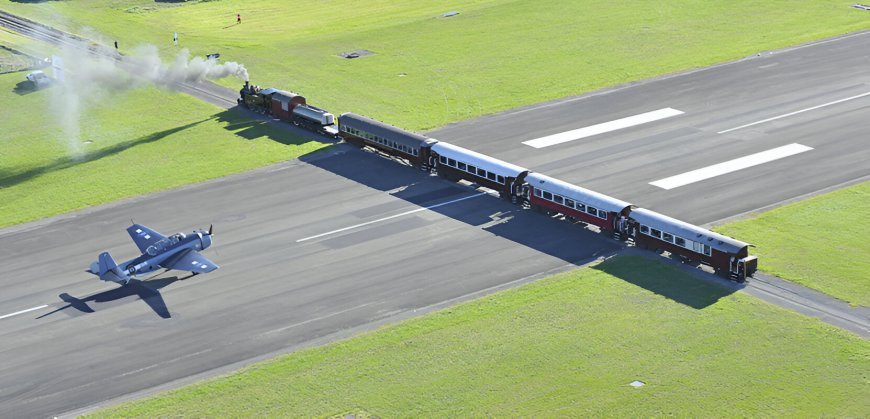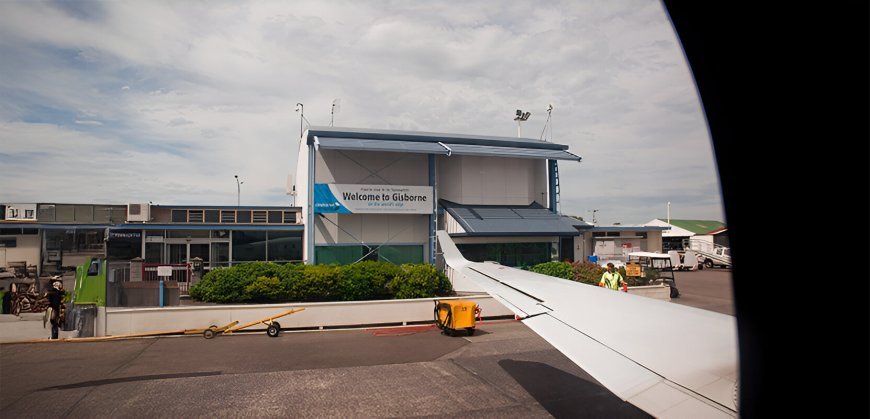Ever Seen a Train Cross a Runway? It Happens Daily at This Airport
At this New Zealand airport, planes don’t always get runway priority. Guess what crosses their path before takeoff?

Imagine descending toward a runway only to see rail tracks cutting right across it. Welcome to Gisborne Airport in New Zealand’s North Island, a regional airfield that sits on 160 hectares of land and is bisected by the Palmerston North–Gisborne railway linendtv.com. Here the hum of a turboprop taxiing is matched by the clatter of a train, a setting that makes aviation fans and train enthusiasts equally giddy.
How Planes and Trains Share the Runway
Both systems run on a strict timetable: planes and trains can use the shared space between 6:30 a.m. and 8:30 p.m. and the runway is closed after thatndtv.com. When a train approaches, airport staff halt aircraft movements; when a plane is preparing to land or take off, the railway signals stop the train. This coordination is essential because the railway actually crosses the runway, not just a taxiway.
Gisborne Airport Handles Both Flights and Trains
This quirky arrangement isn’t a museum stunt. Gisborne Airport handles over 60 domestic flights a week and serves around 150,000 passengers annually. The railway crossing itself is used by the Gisborne City Vintage Railway, a heritage line whose steam locomotives rumble across the runway about 15 times a year, mostly when cruise ship tourists visit in summer.
Gisborne Airport is situated on New Zealand’s east coast and covers nearly 160 hectares. What sets it apart is the railway line from Palmerston North that cuts across its runway. During daily operations from early morning to evening, trains and planes alternate passage, guided by signals controlled by airport personnel.
Every year, about 15 steam train crossings take place right on Gisborne Airport’s runway, managed by the heritage Gisborne City Vintage Railway. These crossings, often tied to cruise ship arrivals, coexist with a busy flight schedule of 60+ weekly domestic services and an annual footfall nearing 150,000.
Reasons to Visit Gisborne Airport
For travellers, Gisborne Airport offers a rare opportunity to witness two modes of transport co existing in harmony. As NDTV puts it, the airport is a “one-of-a-kind wonder” where a train might roll across the runway just as a turboprop waits patientlyndtv.com.

The surrounding region adds to the allure: beyond the airport’s fences lie vineyards, surf beaches and the easternmost city in New Zealand, making this hidden gem a perfect stop for those seeking both novelty and natural beauty.
FAQs
Where is Gisborne Airport located?
Gisborne Airport is situated on the east coast of New Zealand’s North Island. It spans roughly 160 hectares and serves the regional city of Gisborne.
How is Gisborne Airport different from other airports?
Gisborne Airport is unique because an active railway line crosses its main runway, requiring shared use by both trains and aircraft.
How does Gisborne Airport manage safety when trains and planes use the same runway?
At Gisborne Airport, aircraft and trains share the runway in a tightly coordinated schedule between 6:30 a.m. and 8:30 p.m. Airport personnel control signals to stop rail or air traffic as needed to prevent overlap and ensure safe operations.
Who operates the trains that cross the runway at Gisborne Airport?
The trains are operated by Gisborne City Vintage Railway, a heritage line known for its steam locomotives. These trains cross the runway about 15 times annually, mainly during the summer tourism season.
How much air traffic does Gisborne Airport handle?
Gisborne Airport sees more than 60 domestic flights weekly and serves approximately 150,000 passengers per year, making it a key transport hub for the region.
Can visitors watch trains crossing the runway at Gisborne Airport?
Yes. During special heritage runs, often timed with cruise ship arrivals, visitors can witness vintage steam trains crossing the live runway at Gisborne Airport. It’s a rare and memorable sight.
Also Read : US Visa Rule Change: In-Person Interviews Now Mandatory for All Applicants

 Admin
Admin